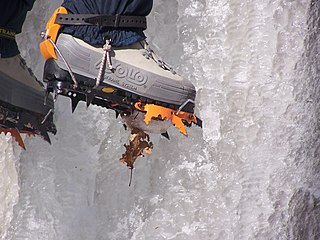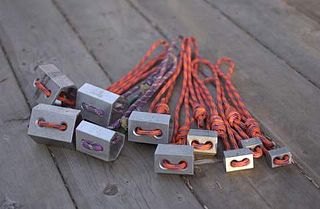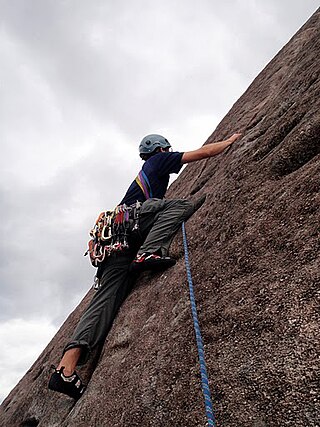
The figure 8 belay device is a piece of metal (usually an aluminum alloy) in the shape of an 8 with one large end and one small end.

The figure 8 belay device is a piece of metal (usually an aluminum alloy) in the shape of an 8 with one large end and one small end.


This device utilizes a large surface area in contact with a climbing rope to provide sufficient friction along with the proper technique to be used as a belay device or for rappelling. A figure 8 (sometimes just referred to as an 8) is used in conjunction with a climbing harness and locking carabiner to control a belayed climber's descent, or one's own descent when rappelling.
Figure-eights offer a smooth controlled descent when rappelling and lowering climbers. [1] They can be used with nearly any diameter climbing rope and don't get as hot as other friction devices because of their ability to dissipate heat efficiently. [2] The figure eight can also be used with a doubled rope, which is also possible with a rack but not a bobbin.
The figure-eight cannot be removed from the rope without detaching the device from the harness, and so could be accidentally dropped, particularly when tackling a rebelay. They also twist the rope which is a particular problem where a rebelay prevents the rope from untwisting. They do not provide a convenient means to temporarily lock the descent at a rebelay.

A spring-loaded camming device is a piece of rock climbing or mountaineering protection equipment. It consists of two, three, or four cams mounted on a common axle or two adjacent axles, so that pulling on the axle forces the cams to spread farther apart. This is then attached to a sling and carabiner at the end of the stem. The SLCD is used by pulling on the "trigger" so the cams retract together, then inserting it into a crack or pocket in the rock and releasing the trigger to allow the cams to expand. A pull on the rope, such as that generated by a climber falling, will cause a properly placed SLCD to convert the pulling force along the stem of the unit into outwards pressure on the rock, generating massive amounts of friction and preventing the removal of the unit from the rock. Because of the large forces which are exerted on the rock when an SLCD is fallen on, it is very important that SLCDs are only placed in solid, strong rock.

A double bowline is a type of loop knot. Instead of the single turn of the regular bowline, the double bowline uses a round turn. This forms a more secure loop than a standard bowline.

A climbing harness is a device which allows a climber access to the safety of a rope. It is used in rock and ice climbing, abseiling, and lowering; this is in contrast to other activities requiring ropes for access or safety such as industrial rope work, construction, and rescue and recovery, which use safety harnesses instead.

A crampon is a traction device attached to footwear to improve mobility on snow and ice during ice climbing. Besides ice climbing, crampons are also used for secure travel on snow and ice, such as crossing glaciers, snowfields and icefields, ascending snow slopes, and scaling ice-covered rock.

An ice axe is a multi-purpose hiking and climbing tool used by mountaineers in both the ascent and descent of routes that involve snow, ice, or frozen conditions. Its use depends on the terrain: in its simplest role it is used like a walking stick, with the mountaineer holding the head in the center of their uphill hand. On steep terrain it is swung by its handle and embedded in snow or ice for security and an aid to traction. It can also be buried pick down, the rope tied around the shaft to form a secure anchor on which to bring up a second climber, or buried vertically to form a stomp belay. The adze is used to cut footholds, as well as scoop out compacted snow to bury the axe as a belay anchor.

Glossary of climbing terms relates to rock climbing, mountaineering, and to ice climbing.

Rock-climbing equipment varies with the type of climbing undertaken. Bouldering needs the least equipment outside of shoes and chalk and optional crash pads. Sport climbing adds ropes, harnesses, belay devices, and quickdraws to clip into pre-drilled bolts. Traditional climbing adds the need for carrying a "rack" of temporary passive and active protection devices. Multi-pitch climbing adds devices to assist in ascending and descending fixed ropes. And finally aid climbing uses unique equipment.

Abseiling, also known as rappelling, is the controlled descent of a steep slope, such as a rock face, by moving down a rope. When abseiling, the person descending controls their own movement down the rope, in contrast to lowering off, in which the rope attached to the person descending is paid out by their belayer.
Self-locking devices are devices intended to arrest the fall of solo climbers who climb without partners. This device is used for rope solo climbing, for "ground-up climbing", and for "top rope solo climbing". To date, several types of self-locking devices have evolved.

Belaying is a variety of techniques climbers use to create friction within a climbing system, particularly on a climbing rope, so that a falling climber does not fall very far. A climbing partner typically applies tension at the other end of the rope whenever the climber is not moving, and removes the tension from the rope whenever the climber needs more rope to continue climbing.

In rock climbing, a nut is a metal wedge threaded on a wire that climbers use for protection by wedging it into a crack in the rock. Quickdraws are clipped to the nut wire by the ascending climber and the rope threads through the quickdraw. Nuts come in a variety of sizes and styles, and several different brands are made by competing manufacturers. Most nuts are made of aluminum. Larger nuts may be threaded on Dyneema cord instead of wire, but this has become unusual.

An ascender is a device used for directly ascending a rope, or for facilitating protection with a fixed rope when climbing on very steep mountain terrain.
Self-arrest is a technique employed in mountaineering in which a climber who has fallen and is sliding down a snow or ice-covered slope arrests the slide by themselves without recourse to a rope or other belay system. Self-arrest can be performed by using ice axe and a combination of a climber's boots, hands, feet, knees and elbows. Use of an ice axe greatly increases the probability of effectively stopping a fall down a snow field, ice field, or glacier.

A Prusik is a friction hitch or knot used to attach a loop of cord around a rope, applied in climbing, canyoneering, mountaineering, caving, rope rescue, ziplining, and by arborists. The term Prusik is a name for both the loops of cord used to tie the hitch and the hitch itself, and the verb is "to prusik". More casually, the term is used for any friction hitch or device that can grab a rope. Due to the pronunciation, the word is often misspelled Prussik, Prussick, or Prussic.

A sling or runner is an item of climbing equipment consisting of a tied or sewn loop of webbing. These can be wrapped around sections of rock, hitched to other pieces of equipment, or tied directly to a tensioned line using a Prusik style knot. They may be used as anchors, to extend an anchor to reduce rope drag, in anchor equalization, or to climb a rope.
In rock climbing, an anchor can be any device or method for attaching a climber, a rope, or a load above or onto a climbing surface—typically rock, ice, steep dirt, or a building—either permanently or temporarily. The intention of an anchor is case-specific but is usually for fall protection, primarily fall arrest and fall restraint. Climbing anchors are also used for hoisting, holding static loads, or redirecting a rope.

An ice screw is a threaded tubular screw used as a running belay or anchor by climbers on steep ice surface such as steep waterfall ice or alpine ice during ice climbing or crevasse rescue, to hold the climber in the event of a fall, and at belays as anchor points.

A belay device is a mechanical piece of climbing equipment used to control a rope during belaying. It is designed to improve belay safety for the climber by allowing the belayer to manage their duties with minimal physical effort. With the right belay device, a small, weak climber can easily arrest the fall of a much heavier partner. Belay devices act as a friction brake, so that when a climber falls with any slack in the rope, the fall is brought to a stop.

A hex is an item of rock-climbing equipment used to protect climbers from falls. They are intended to be wedged into a crack or other opening in the rock, and do not require a hammer to place. They were developed as an alternative to pitons, which are hammered into cracks, damaging the rock. Most commonly, a carabiner will be used to join the hex to the climbing rope by means of a loop of webbing, cord or a cable which is part of the hex.

Slab climbing is a type of rock climbing where the rock face is at an angle less steep than vertical. It is characterized by balance- and friction-dependent moves on very small holds. It is often not leadable, or climbable from the ground up, unless it has pre-drilled bolts to protect the climb, making most slab climbs either top rope climbing or sport climbing. Special techniques such as smearing are necessary to climb slab. It is a type of face climbing and is distinctly different from crack climbing. Slab climbing is a relatively new area of climbing, having become more popular in the last 30 years, and some of the highest graded routes are currently being realized.